What is an advertorial?
It is a mish-mash of the words advertising and editorial.
Advertorials take the best of both worlds from copywriting and article writing, combining them to create a whole separate beast.
They are written to entertain, persuade, and ultimately sell something. Since an advertorial is not just copy or an article, it is one of the most difficult sales materials to produce.
Consumers are more aware than ever about how often they are advertised, and traditional forms are no longer working as they used to in the past.
This is why businesses have begun investing in advertorials, as it acts as a soft sell using stories and valuable content to attract customers.
Let what Merkle found in Q4 of 2017 sink in, for example.
The volume of search ad clicks slowed by 9%, yet the average cost per click rose by 14%. Spending increased by 24% year over year on top of this.
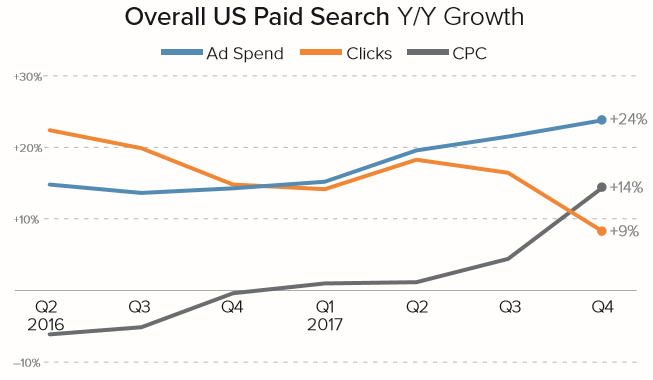
We need better ways to reach customers.
…Better ways to diversify.
…Better ways to add value.
Being able to write good advertorials is a skill that every serious writer needs because of this.
Even if you don’t plan to write them yourself and need content writing services from someone like me, it’s key to understand how they work so you can grade what a writer creates for you.
Follow along as I teach you how to write an advertorial and analyze real-world examples.
Why are advertorials important?
Advertorials are incredible tools for generating leads and sales.
They are important for marketers because they allow you to sell a product while telling a story and offering value.
Take the average affiliate blog post, for example.
It’s riddled with sneaky referral links in hopes of generating commissions.
I get it. You gotta make that money. But, you don’t have to be so sly about it.
Advertorials get around this by confidently discussing a product and its benefits but not neglecting the reader.
Information, data, and other useful tidbits are presented along with it. Otherwise, it’d be a full-blown advertisement.
It’s the perfect piece of content to write when you want to promote a product but not lose value and information.
Advertorial examples
Next, I’m going to break down examples of real advertorials, the strategies they used, and how you can mimic their success.
Check it out. 👇
Social Worker advertorial
Emotion is everything in copywriting.
If you’re not pulling on someone’s heartstrings with your writing, it isn’t going to move the needle. Not one bit.
Whoever was the talented writer that put together this advertorial for social worker jobs knew that:

A bold headline states, “Pay It Forward,” which acts as a call to action while grabbing readers’ attention.
The sub-headline mentions a person’s name—Fareez—to immediately prime the reader for the story.
The copy jumps right into the good stuff by saying, “Losing his father when he was 15 presented a turning point for Mohammed Fareez.”
It’s powerful. It’s emotional.
That’s not something you can read and smile about. Naturally, it brings out feelings in the reader and gets them hooked.
This continues by the advertorial reading, “Apart from the emotional pain, Fareez, his elder brother and widowed mother had other pressing concerns—how to cope financially.”
The remainder of the piece uses quotes from Fareez and the story of how he obtained a Social Work degree to become financially stable and help his family.
It uses a similar formula that hero stories use: the hero encounters an obstacle, fights through it, and then becomes victorious.
Try applying that formula to your advertorial or, at minimum, making it emotionally driven and personal.
Dos Equis
C’mon. You loved those Dos Equis commercials with the “Dos Equis” guy.
I know I did.
While most of us witnessed these beautiful ads through the television, the beer brand did their fair amount of physical advertising, including this advertorial:
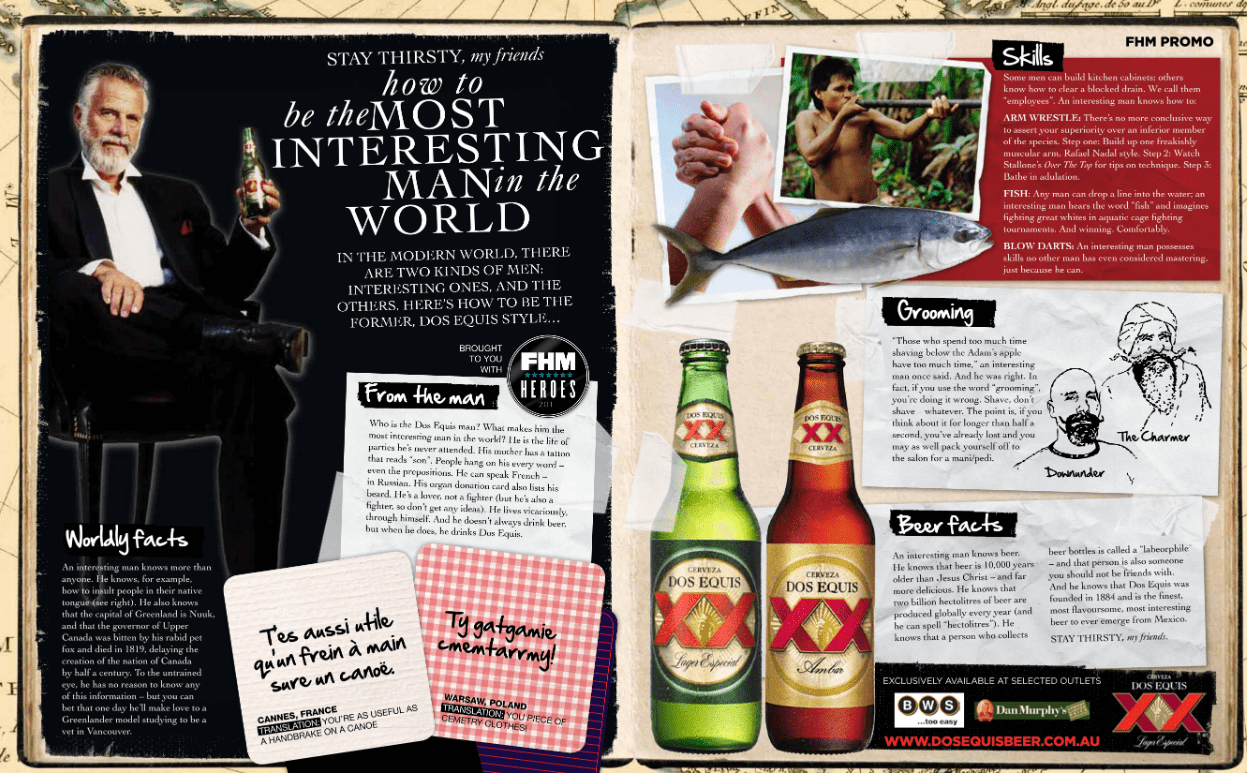
The headline reads their famous saying “Stay thirsty, my friends” followed by “How to be the most interesting man in the world.”
This is a great branding play. If you’ve heard of Dos Equis, you’ll immediately recognize them and be attentive.
Reminiscent of David Ogilvy’s work, the ad heavily focuses on the concept of the character to make the product stand out and be memorable. (Think of the man in the Hathaway shirt.)
Because let’s be real.
Would you remember this beer without the guy? Probably not!
It uses different puns like “He is the life of the parties he’s never attended. His mother has a tattoo that reads ‘son.’ People hang on his every word—even the prepositions.”
The other sections continue to build off of the “Dos Equis guy” while gently positioning the product.
Next time you’re writing an advertorial, try anchoring the product to a story or character.
This makes it glue to the readers’ brains while making it more entertaining and emotionally appealing.
How to write advertorials
Now that you understand what an advertorial is and have seen some examples let’s dive into some tips and advertorial guidelines.
Understand the publication you’re writing for
Every magazine and business has a unique voice, tone, and audience. This is why it’s crucial that you study how the magazine typically voices its content.
Is it casual and personal, like friends talking?
Is it serious and professional?
Read previous issues, articles, etc to determine the standard voice they use.
I would also recommend consulting with an editor to get further insight into writing guidelines that any major publication will have on hand.
Understanding how a business structures and designs its pages will allow you to craft an advertorial that looks the same way.
This maximizes the chance of it being accepted by the publication and the audience resonating with it.
Study the publication. Take notes, brainstorm, and don’t be afraid to ask questions to clients you are working with.
Research is one of the most underrated steps in copywriting, so don’t jump straight into writing without doing it first.
Research the audience
Did you know that 58% of B2B marketers agree that having a clear buyers persona is the most important element of content marketing effectiveness?
This means that if you don’t have a good understanding of a publication’s audience, you are very likely to write an advertorial that doesn’t resonate with them.
When I write copy for clients, one of the first things I like to learn about is their target audience. What are their demographics? What do they struggle with? What are they trying to learn?
All of this information is at your fingertips. You simply have to ask the client for it. They should have more than enough data and material to give you to get into the heads of readers.
Another place I’d go to is the comments section, presuming it’s a digital publication. Here you will gain insight into the reader’s questions, concerns, and ideas.
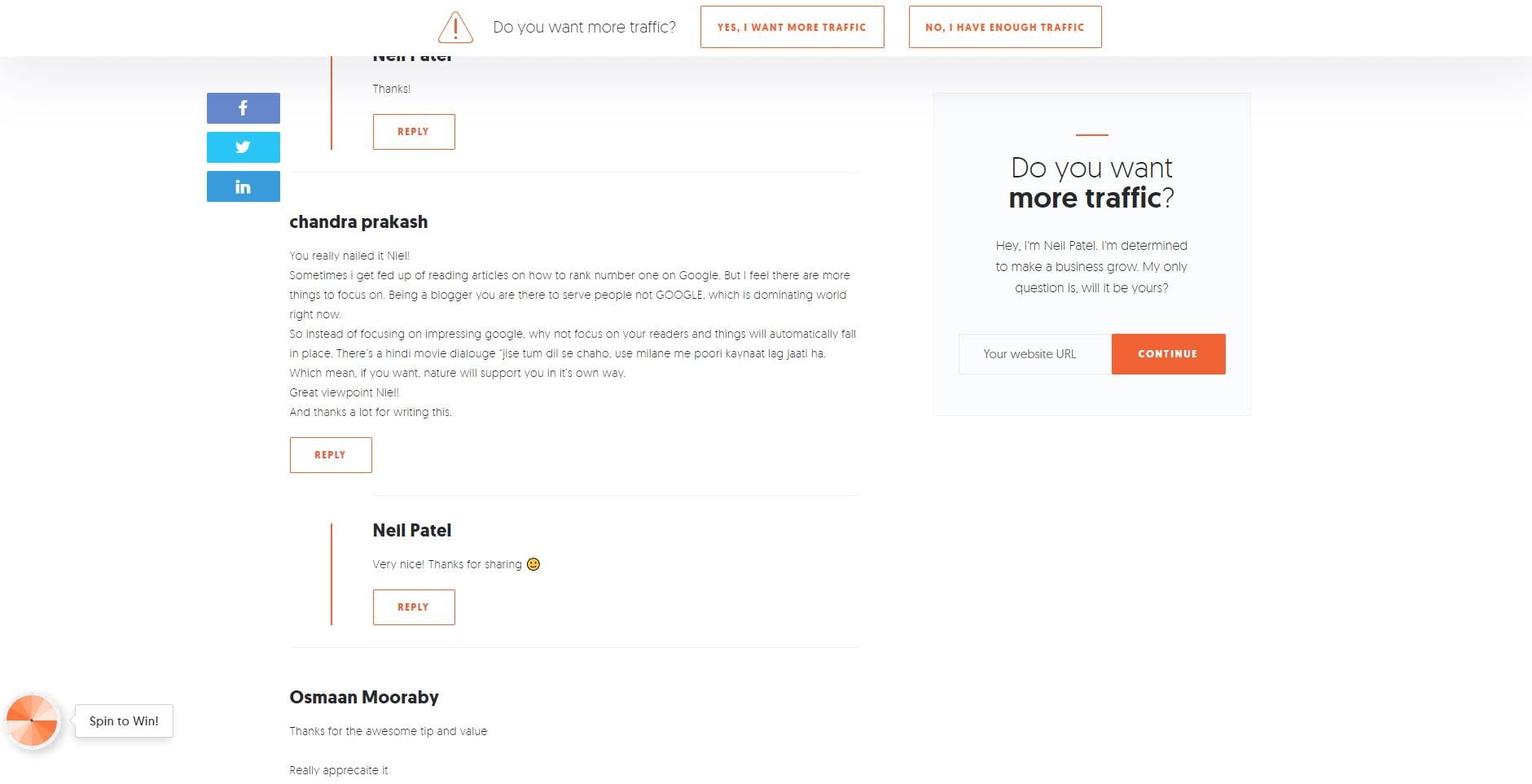
Similarly, you can go onto networks like Twitter, and search for keywords to find relevant discussions.
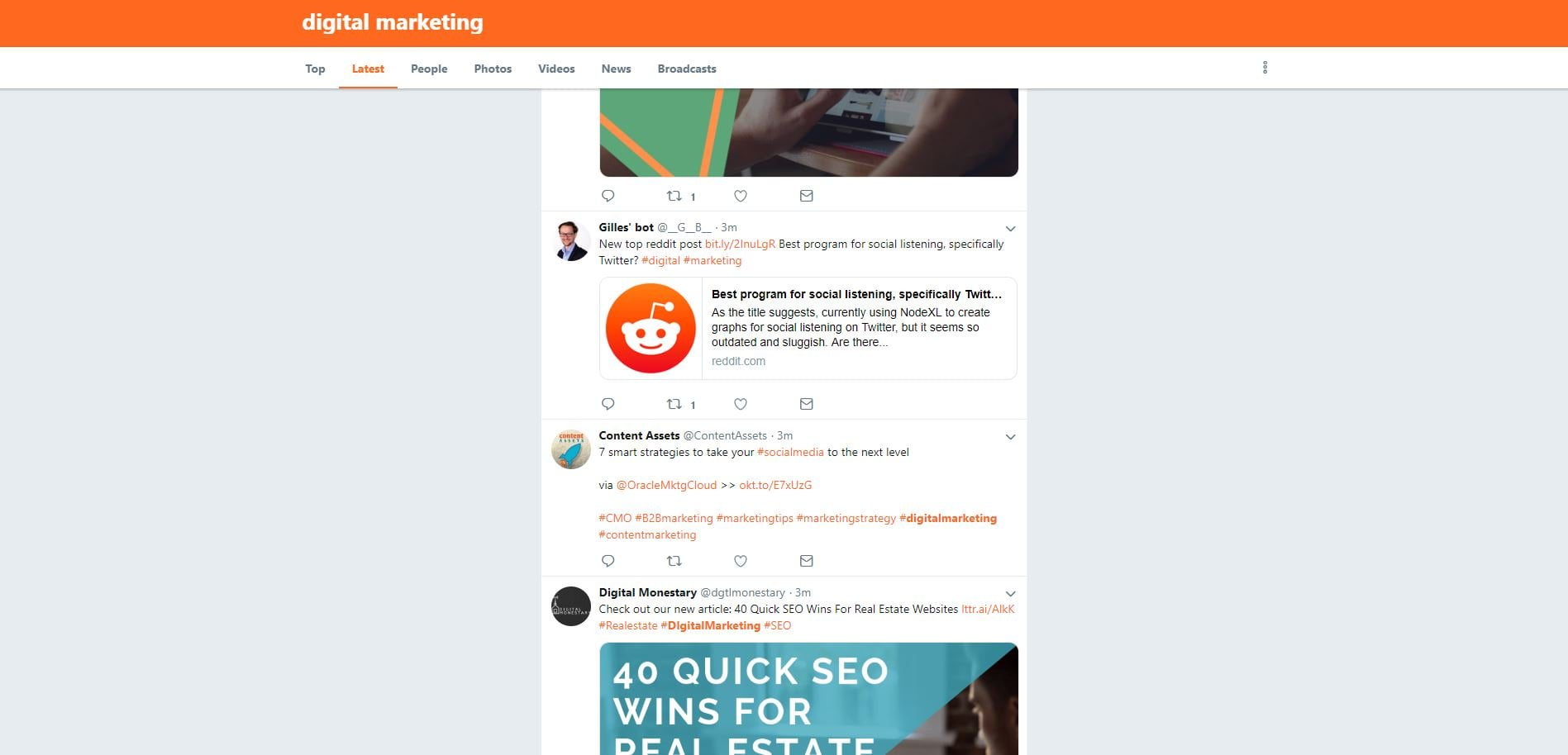
Pay attention to what trends you see in terms of audience, questions, or opinions. All of these will influence how you write an advertorial.
Master the headline
The average news consumer reads a headline, and that’s it.
If your headline sucks, that means nobody is going to get drawn into the copy.
Think of it as a slippery slope. Every headline, sentence, and paragraph should lead smoothly into the next.
There are many different strategies you can use to write great headlines, but the first thing you should do is study the publication to look at previous ones.
This will give you a good idea of what headlines perform well, and what they normally like to publish.
Imagine you were writing for Chief Content Officer, for example. You could take a look at the features, and make notes on how headlines were produced.
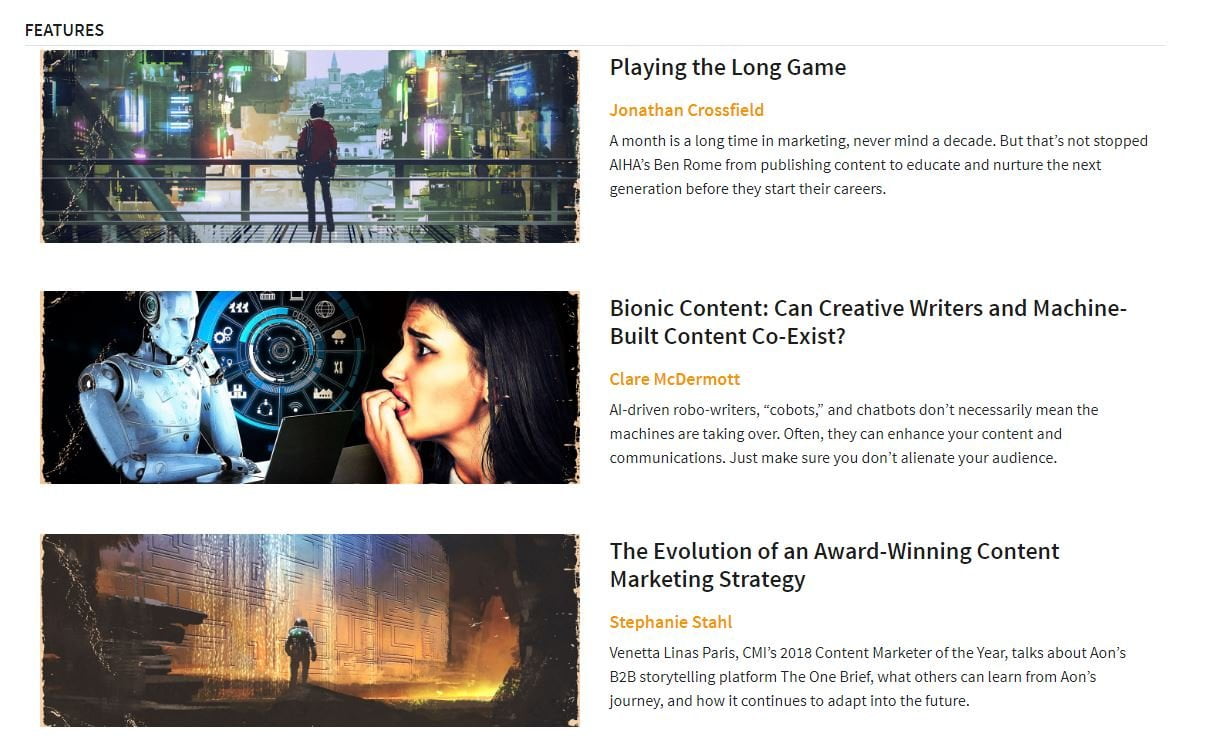
With that being said, here are some tried and true headline techniques to use when writing advertorials:
Urgency
Creating a sense of urgency makes readers want to read content because they feel like they will miss out on something great.
This is also called fear of missing out, or FOMO for short.
Heck, it’s been found that 60% of millennials make purchases based on FOMO alone.
You can create urgency in headlines by using phrases or words like:
- Hurry
- Quick
- Now
- Today
- Soon
- Limited
- Secrets
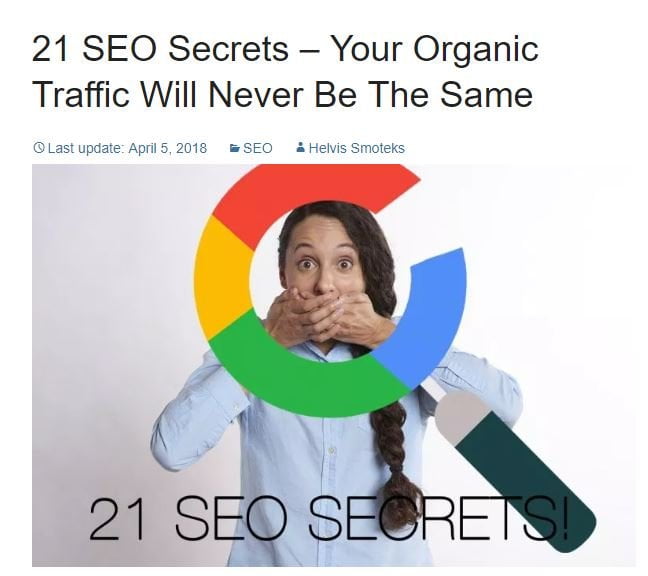
Ask a question
With knowledge about a target audience, you have the leverage to create a headline that asks a question they are thinking about.
If you were writing an advertorial on web design and user experience, the headline could be “Trying to Optimize Your Website UX? Read These 5 Tips.”
Remember that most people are seeking information or trying to solve a problem by reading content, so they obviously have a question on their mind.
If you can study a buyer’s persona well enough that you can predict these questions, you will easily hook them in with the headline and get them closer to the point of sale.

Learn from Buzzfeed
Clickbait headlines work.
I still fall for them from time to time myself.
Buzzfeed is known as the king of clickbait headlines, and while some people look down upon it, I think there’s plenty to learn from them.
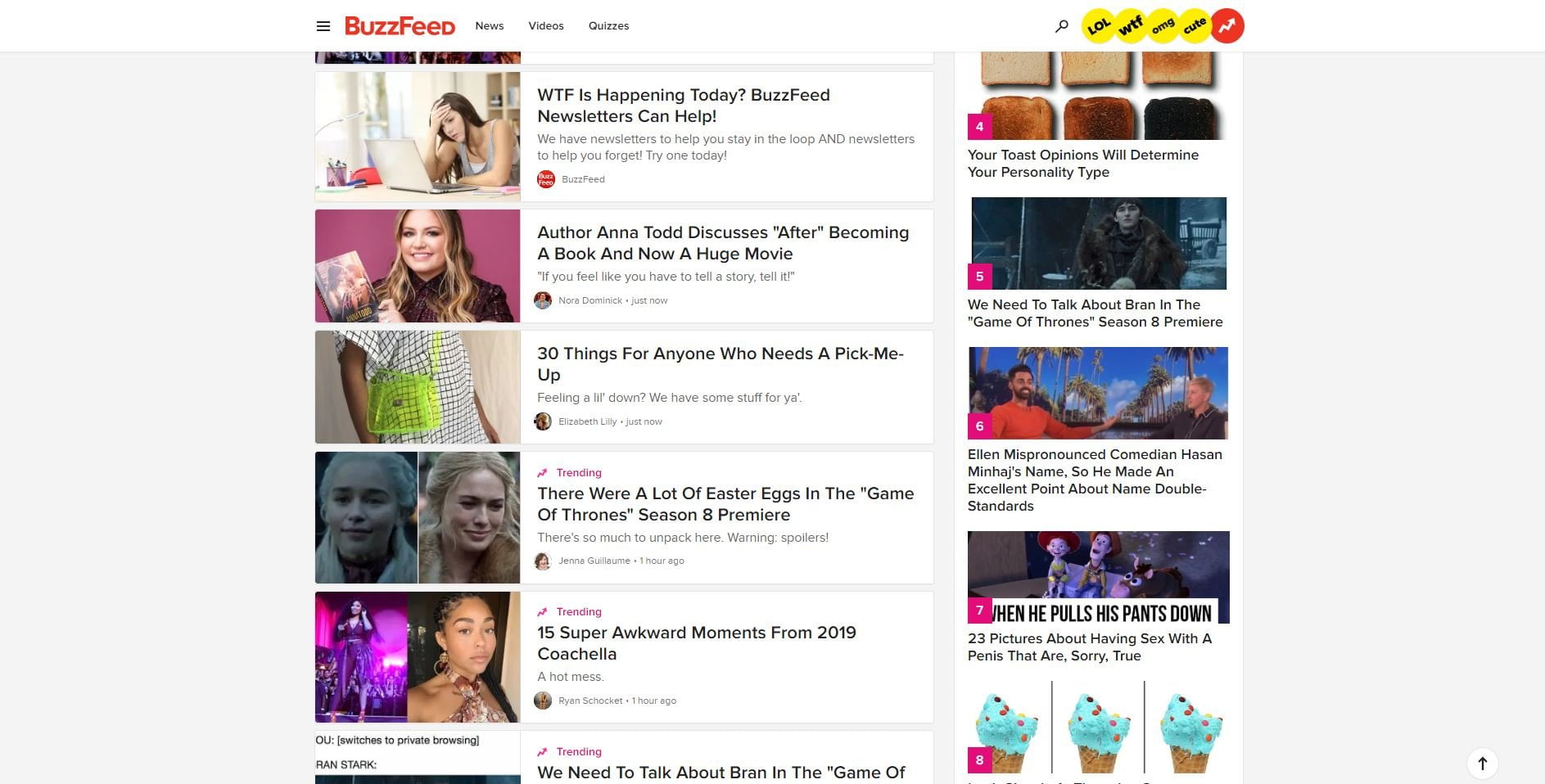
Look at the front page of their website, for example. Notice how their headlines ask questions, make bold statements, and some are flat-out controversial.
This snags people’s attention and gets them into the meat and potatoes of content where the money is made.
For them, advertising.
For you, selling a product.
Take advantage of storytelling
Think back to when we were cavemen. (Or entertain the idea.)
We didn’t have fancy-schmancy smartphones, the internet, or anything remotely advanced. Not even close.
Naturally, we told stories through our words, body language, and paintings.
This was how we communicated.
In fact, we still do to this day.
Reflect back on the social worker advertorial I analyzed.
It was focused on telling the story of one man. His family. His experiences. His hardships.
Whether it’s on paper or you gossiping about that weird thing your Mom tweeted, we’re constantly storytelling.
As Pamela B. Rutledge Ph.D., put it, “Stories are about collaboration and connection. They transcend generations, they engage us through emotions, and they connect us to others. Through stories, we share passions, sadness, hardships, and joys. We share meaning and purpose.”
Stories take place in our imagination. A.K.A, they make us feel things and see them as real experiences.
They are also the pathway to engaging the right hemisphere of the brain—the side responsible for emotion, creativity, and intuition if you flunked science class.
Center the advertorial around a real person. They’re a real story.
Make it personal, transparent, and honest.
What does the product really do?
Imagine we’re writing an advertorial to promote a college.
We could mention the reasonable tuition, variety of programs, and great campus atmosphere.
But, what does that really mean to the reader?
Not a whole lot.
Let me tell you why…
One of the most important aspects of copywriting is elaborating on the benefits of a product—not just the features.
Features are factual. The benefits are emotional.
Taking the previous example in mind, we could say things like:
- Reasonable tuition keeps more money in your pocket to save, invest, and not be crippled by student loan debt.
- A variety of programs allow you to pursue your passion and prepare for an exciting lifelong career in any field.
- Events, clubs, and more connect you with other students to make friends and get involved in the school community.
Please make sure when you’re writing advertorials that you clearly define the emotional appeal of what you’re selling.
After all, that’s why customers are fundamentally interested in anything!
End it with a call to action
No piece of copy in any form is complete without a call to action.
CTAs are phrases or words that instruct readers what to do next.
Sometimes they need a little push in the right direction or don’t know what to do next which is why they are so effective.
If you look at the advertorial examples I covered earlier, you will notice that they all include a call to action of some sort.
They can be used to generate sales, collect emails, or forward users to another part of a website.
I wrote a guide on calls to action if you’d like to see examples and learn more about them.
Advertorial checklist
Okay, so you rub your palms together, crack your knuckles, and you’re ready to write an advertorial. Use this checklist before, during, and after to ensure that you’ve crafted the perfect advertorial:
- An epic headline: Your headline will draw readers in, so it needs to be attention-grabbing. This means using strategies like urgency, mystery, stating benefits, and being very specific.
- A great intro: The headline gets them in, but the introduction makes them stay. Write an intro that is easy to read and flows well into the rest of the article.
- Relevant stories: Include a story about how the product changed the life of a previous customer. Mention precise numbers, stats, etc if available.
- The product, of course: Go over the details of the product and the benefits of using it.
- Data to back up claims: Use science, studies, and other resources to make your advertorial trustworthy and authoritative.
- Images: Claude Hopkins said images are like salespeople. They can help sell a product or make a point more clear so use photos strategically.
- Call to action: Have a clear call to action, or many, that guide the reader towards the sale.
Here’s an infographic to sum up these points as well:
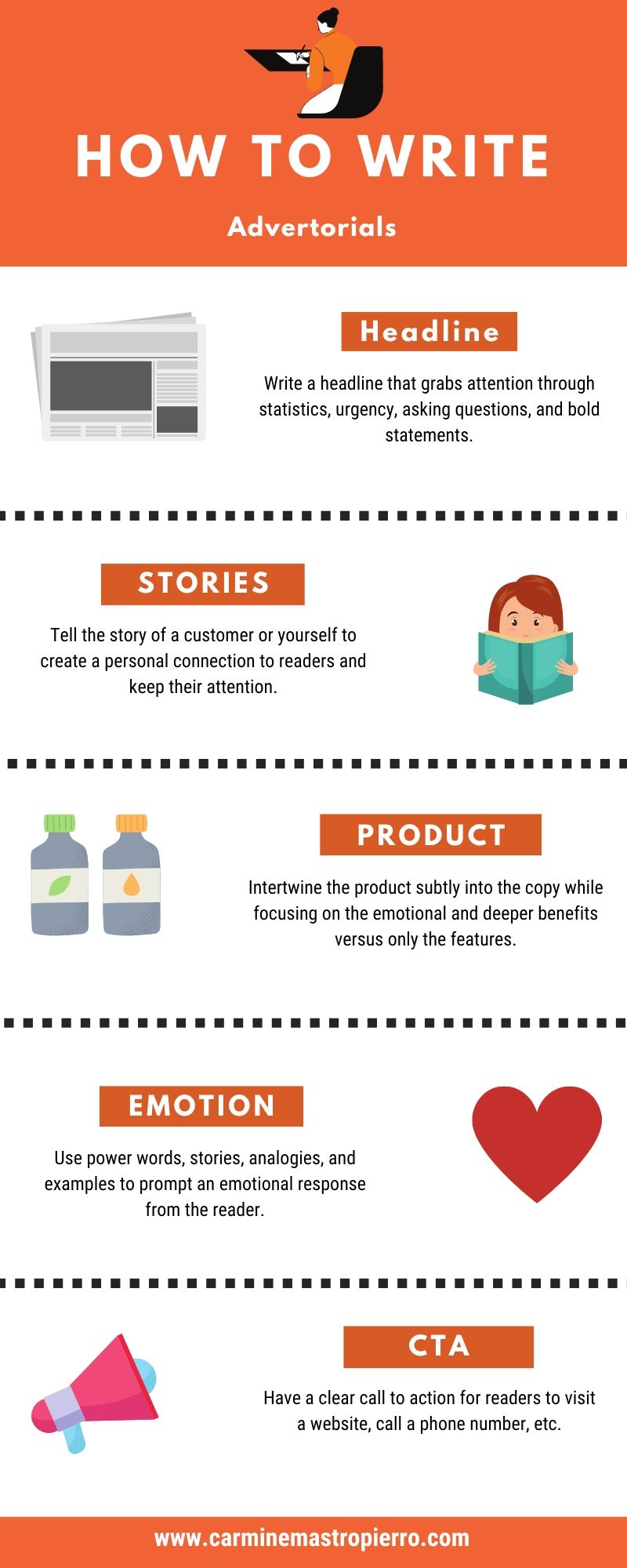
Final thoughts on writing advertorials
An advertorial is a combination of an advertisement and an editorial, hence the name.
The goal of one is to educate, entertain, and inspire an audience while also selling a product.
The first step to write a good advertorial is to understand the publication you’re writing for. This means researching their voice, audience, design, headlines, and every other detail to write something inline with their brand.
Secondly, copywriters need to take time to craft an excellent headline that draws readers in and stands out from the crowd. Urgency, questions, and clickbait titles work very well here.
Lastly, always end an advertorial with a call to action for purchasing a product, signing up for a newsletter, or other important steps in the sales funnel.
Schedule a free consultation to learn more about my marketing services that will help your business drive more revenue.














